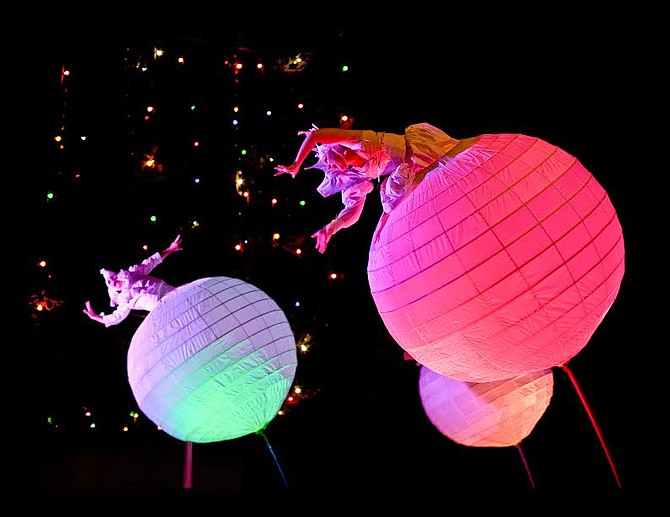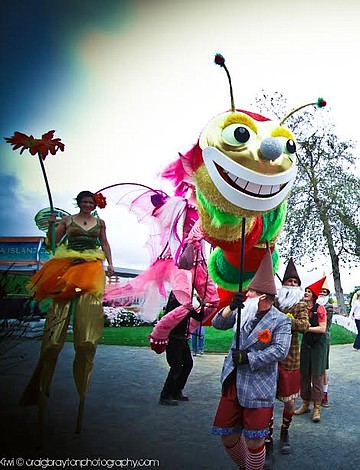 Facebook
Facebook
 X
X
 Instagram
Instagram
 TikTok
TikTok
 Youtube
Youtube

The La Jolla Playhouse’s popular Without Walls Festival begins Friday, October 9 and runs through October 11. That’s 22 events in three days, and all are “site-specific.”
“The Playhouse has four theaters,” says artistic director Christopher Ashley, “the Weiss, the Potiker, the Forum, and the Shank. All are bounded by four walls.”
Site-specific and immersive theater take audiences outside the traditional set-up where spectators sit before a stage, the invisible “fourth wall” in between, and observe from afar.
Site-specific works turn the world into a stage, and a play into an “event.” Playwrights choose an actual place — a really realistic set, if you will — that best enhances their work. In previous festivals, these “sets” have included La Jolla Shores Beach, where a 30-foot Venus arose from the whitewater, and the baby blue house, eerily tilted to one side, on the roof of UCSD’s Jacobs School of Engineering, where Hedda Gabler suffered emotional vertigo.
The most famous, and returning this year for two weeks, are the Car Plays: ten-minute scenes performed in cars and, says Ashley, “the audience is 14 inches from the actors!
“Across the theater landscape, artists are asking, ‘what is a play, how does it work, and where can it work?’ There’s a tremendous energy around site specific work right now. The world has all this richness; places are evocative with stories to tell. The line between the art and the world can vanish.”

One example: the Playhouse’s Accomplice: San Diego was a murder mystery set in Little Italy – much of Little Italy. Groups moved from building to street to building, gathering information. After a while, everyone on India Street looked suspicious: that woman rushing by with a sealed coffee cup — is she the culprit, or does she have our next clue? Is everyone an actor?
Artists are also rethinking the idea of an audience. In site specific work, people can follow along, often on foot, and participate, usually as a character in the scene without lines (and at times with them). “There are no designated seats,” says Ashley. “It’s all general admission. You can sit or stand where you please. Often because of this a group will bond. They come together, even though their experience of the piece will be completely personal.”
The Without Walls paradigm, says Ashley, “means no paradigm at all. Every performance has the sense of a unique event. It’s not a play or a production, with definite time-slots (from one hour to two hours, 45 minutes). Instead, each event runs on its own ‘artistic time.’”
Sites for this year’s festival include: the Stonehenge sculpture on the Revelle College lawn (Dances With Walls, Jean Isaacs San Diego Dance Theater), the hillside tennis court overlooking Scripps Institute (The Trip’s Three Sisters), and UCSD’s Powell Structural Lab (Sledgehammer Theatre’s Heaven on Earth).
Ashley envisions “a three-day arts party.” Along with the 22 events, the festival offers “family friendly, interactive things to do.” Many, like Fern Street Circus’ The Adventures of Heartman and Animal Cracker Conspiracy’s Gnomesense! A Puppet Happening in the Garden, are free.
One of the most exciting aspects of the festival for Ashley: “San Diegans are becoming intrepid, venture-outers. They’re embracing the new, the untested. I love that!”


The La Jolla Playhouse’s popular Without Walls Festival begins Friday, October 9 and runs through October 11. That’s 22 events in three days, and all are “site-specific.”
“The Playhouse has four theaters,” says artistic director Christopher Ashley, “the Weiss, the Potiker, the Forum, and the Shank. All are bounded by four walls.”
Site-specific and immersive theater take audiences outside the traditional set-up where spectators sit before a stage, the invisible “fourth wall” in between, and observe from afar.
Site-specific works turn the world into a stage, and a play into an “event.” Playwrights choose an actual place — a really realistic set, if you will — that best enhances their work. In previous festivals, these “sets” have included La Jolla Shores Beach, where a 30-foot Venus arose from the whitewater, and the baby blue house, eerily tilted to one side, on the roof of UCSD’s Jacobs School of Engineering, where Hedda Gabler suffered emotional vertigo.
The most famous, and returning this year for two weeks, are the Car Plays: ten-minute scenes performed in cars and, says Ashley, “the audience is 14 inches from the actors!
“Across the theater landscape, artists are asking, ‘what is a play, how does it work, and where can it work?’ There’s a tremendous energy around site specific work right now. The world has all this richness; places are evocative with stories to tell. The line between the art and the world can vanish.”

One example: the Playhouse’s Accomplice: San Diego was a murder mystery set in Little Italy – much of Little Italy. Groups moved from building to street to building, gathering information. After a while, everyone on India Street looked suspicious: that woman rushing by with a sealed coffee cup — is she the culprit, or does she have our next clue? Is everyone an actor?
Artists are also rethinking the idea of an audience. In site specific work, people can follow along, often on foot, and participate, usually as a character in the scene without lines (and at times with them). “There are no designated seats,” says Ashley. “It’s all general admission. You can sit or stand where you please. Often because of this a group will bond. They come together, even though their experience of the piece will be completely personal.”
The Without Walls paradigm, says Ashley, “means no paradigm at all. Every performance has the sense of a unique event. It’s not a play or a production, with definite time-slots (from one hour to two hours, 45 minutes). Instead, each event runs on its own ‘artistic time.’”
Sites for this year’s festival include: the Stonehenge sculpture on the Revelle College lawn (Dances With Walls, Jean Isaacs San Diego Dance Theater), the hillside tennis court overlooking Scripps Institute (The Trip’s Three Sisters), and UCSD’s Powell Structural Lab (Sledgehammer Theatre’s Heaven on Earth).
Ashley envisions “a three-day arts party.” Along with the 22 events, the festival offers “family friendly, interactive things to do.” Many, like Fern Street Circus’ The Adventures of Heartman and Animal Cracker Conspiracy’s Gnomesense! A Puppet Happening in the Garden, are free.
One of the most exciting aspects of the festival for Ashley: “San Diegans are becoming intrepid, venture-outers. They’re embracing the new, the untested. I love that!”
Comments